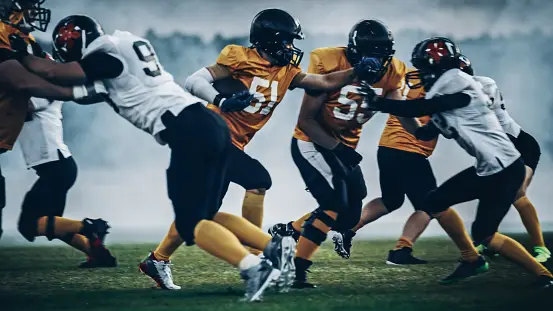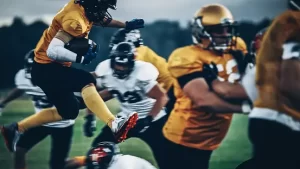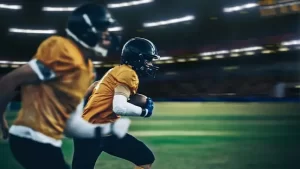In football, the fullback plays a crucial role on both the offensive and defensive sides of the ball. Despite its name, the fullback position varies depending on the type of football being played – soccer or American football. The responsibilities, skills, and characteristics of fullbacks differ based on the sport, so it’s important to understand the distinctions between soccer fullbacks and those found in American football. What is a Full Back in Football?
In soccer, fullbacks are wide defenders that are positioned on either side of the back four, typically playing as a right back or left back. Their primary objective is to defend their quadrant by marking the opposition’s winger, winning defensive duels in wide areas, and preventing crosses. On the other hand, American football’s fullback is an offensive player that primarily serves as a blocker but has the ability to run and catch the ball when necessary. Their physical attributes and skills often align with those of a tight-end player, making them valuable assets on the offense.
Contents
Understanding the Full Back Position
Role and Responsibilities
A fullback (FB) is a position in the offensive backfield in gridiron football, and is one of the two running back positions along with the halfback. The fullback primarily acts as an offensive blocker, providing crucial support in the running game by creating clear paths for running backs and quarterbacks. However, a fullback can also run and catch the ball on plays, depending on the team’s offensive strategy. The size of a fullback is typically similar to a tight-end player, which allows them to have various roles to perform on offense.
Some key responsibilities of a fullback include:
- Identifying the correct player to block
- Blocking linebackers and safeties to open up lanes for the primary ball carriers
- Catching passes and occasionally carrying the football as a ball carrier
- Contributing to special teams, particularly in kick return formations
Historical Evolution
The fullback position has evolved significantly over the history of gridiron football. In earlier years, fullbacks were primarily utilized as ball carriers and played a central role in the running game. However, as offensive strategies shifted towards a more pass-oriented approach, the role of the fullback began to change as well.
Modern fullbacks focus more on blocking and providing additional pass protection for the quarterback, while also occasionally being targeted in short passing plays. Due to these changes, fullbacks in today’s game are often required to be versatile athletes who can effectively contribute to multiple aspects of the offense.
The position of fullbacks in recent years has also become more specialized, with some teams employing them as hybrid players, often taking on the roles and responsibilities of both a traditional fullback and a tight end. These hybrid fullbacks are particularly useful in creating matchup problems for opposing defenses, as they have the size and strength to block but also possess the agility and receiving skills necessary to contribute as pass catchers.
Types of Full Backs
There are different types of fullbacks in football, and their roles can vary depending on the team’s formation and strategy. In this section, we will discuss the following types of fullbacks: Attacking Full Backs, Defensive Full Backs, and Wing Backs.
Attacking Full Backs
Attacking Full Backs are players who contribute significantly to their team’s offensive play, often acting as additional wingers when their team is in possession. These fullbacks have a good balance between their defensive duties and attacking responsibilities. They are often:
- Fast and agile, capable of making overlapping runs down the wings
- Good at crossing the ball into the penalty area for forwards
- Skillful in dribbling and taking on opposition defenders
Some examples of famous attacking fullbacks include Marcelo from Brazil and Jordi Alba from Spain.
Defensive Full Backs
Defensive Full Backs prioritize their defensive duties over their attacking contributions. These players tend to:
- Have a strong physical presence and tackling ability
- Maintain a disciplined position when their team is not in possession
- Focus on breaking up opposition attacks and preventing crosses
Defensive fullbacks are often relied upon to mark and neutralize dangerous wingers from the opposing team. Some well-known defensive fullbacks are Philipp Lahm from Germany and Ashley Cole from England.
Wing Backs
Wing Backs are a hybrid between fullbacks and wingers, playing slightly more advanced roles in formations that have three central defenders. They are typically used in 3-5-2 or 5-3-2 formations, where they have greater freedom to support the attack without neglecting their defensive responsibilities. Key characteristics of wingbacks include:
- Exceptional stamina to cover both defense and attack along the flank
- Adept at providing width and crossing the ball into the opponent’s box
- Balancing defensive and offensive duties, depending on the in-game situation
Notable wingbacks in football history are Roberto Carlos from Brazil and Cafu from Brazil.
Full Back Skills and Attributes
Physical Fitness and Stamina
Full backs in football require exceptional physical fitness and stamina. They must be fast enough to keep up with their opponents’ wingers and have the endurance to maintain their pace throughout the match. Their agility allows them to beat opposing players, while their lower body strength aids in tackling and challenges.
Some notable skills for physical fitness and stamina in full backs include:
- Acceleration and speed
- Balance and agility
- Endurance to run for 90 minutes or more
- Lower body strength for tackling and challenges
Tackling and Defensive Capabilities
A full back’s primary role is to defend their quadrant on the pitch. They must have strong tackling abilities and awareness to close down the opposition players, intercept passes, and win defensive duels in wide areas. Good positioning and decision-making skills are crucial to ensure they can effectively carry out their defensive duties.
Key attributes for full back’s tackling and defensive capabilities are:
- Solid one-on-one defensive skills
- Anticipation and ability to read the game
- Adept at tackling, marking, and intercepting
- Decision-making and positioning intelligence
Crossing and Offensive Contributions
While their primary role is to defend, full backs are also expected to contribute offensively. They often support the wingers and midfielders in attacks, providing width and delivering crosses into the box. Crossing accuracy, dribbling abilities, and effective decision-making in the final third can have a significant impact on a team’s attacking threat.
Important offensive skills for full backs are:
- Accurate crossing
- Dribbling and control in tight spaces
- Overlapping runs in support of attacking players
- Decision-making and vision in the final third
Famous Full Backs
Notable Players in History
The fullback position has seen some incredible players who have left their mark on the history of football. Some notable fullbacks in the history of the NFL include:
- Jim Brown: Widely considered one of the greatest football players of all time, Brown played as a fullback for the Cleveland Browns from 1957 to 1965. He was a nine-time Pro Bowl selection and a three-time MVP.
- John Riggins: Riggins played as a fullback for the New York Jets and the Washington Redskins from 1971 to 1985. He was a key player during the Redskins’ Super Bowl XVII victory and was named the Super Bowl MVP.
- Lorenzo Neal: One of the most powerful and quick fullbacks with great hands. Blocked for one of the best running backs of all time with LaDainian Tomlinson
- Mike Alstott: Famously strong powerful fullback who not only blocked well but ran the ball very well like a running back.
Lorenzo Neal leading for Mike Alstott. That is peak football. https://t.co/EdhSpXZidS
— Brandon Thorn (@BrandonThornNFL) July 1, 2021
Influential Current Full Backs
The present-day NFL has several talented fullbacks who play crucial roles for their teams. Some of the most influential fullbacks in the NFL today are:
-
- C.J. Ham: Ham has been a versatile player for the Minnesota Vikings since joining the team in 2016. He excels in both blocking and receiving roles, earning him a Pro Bowl selection in 2019.
- Kyle Juszczyk: As a member of the San Francisco 49ers, Juszczyk has established himself as one of the league’s best fullbacks through his skillful blocking, rushing, and pass-catching. He has been selected to the Pro Bowl in each season from 2016 to 2020.
FULLBACK TD. 😍
Kyle Juszczyk stays on his feet and scores the first TD for the 49ers (+1.5) ‼️
✅ +1600 to score a TD in first half.
✅ Over 12.5 receiving yards. pic.twitter.com/9PMzXms6aK
— Action Network (@ActionNetworkHQ) February 3, 2020
- Patrick Ricard: Ricard plays as a fullback, defensive lineman, and special teams contributor for the Baltimore Ravens. He has been named to the Pro Bowl twice, showcasing his value to the team across multiple positions.
Other noteworthy fullbacks in the NFL include Andy Janovich, Jamize Olawale, Reggie Gilliam, Alec Ingold, Bruce Miller, Cullen Gillaspia, Anthony Sherman, and Keith Smith. These players exhibit a mix of blocking, running, and catch capabilities that contribute significantly to their teams’ success.



